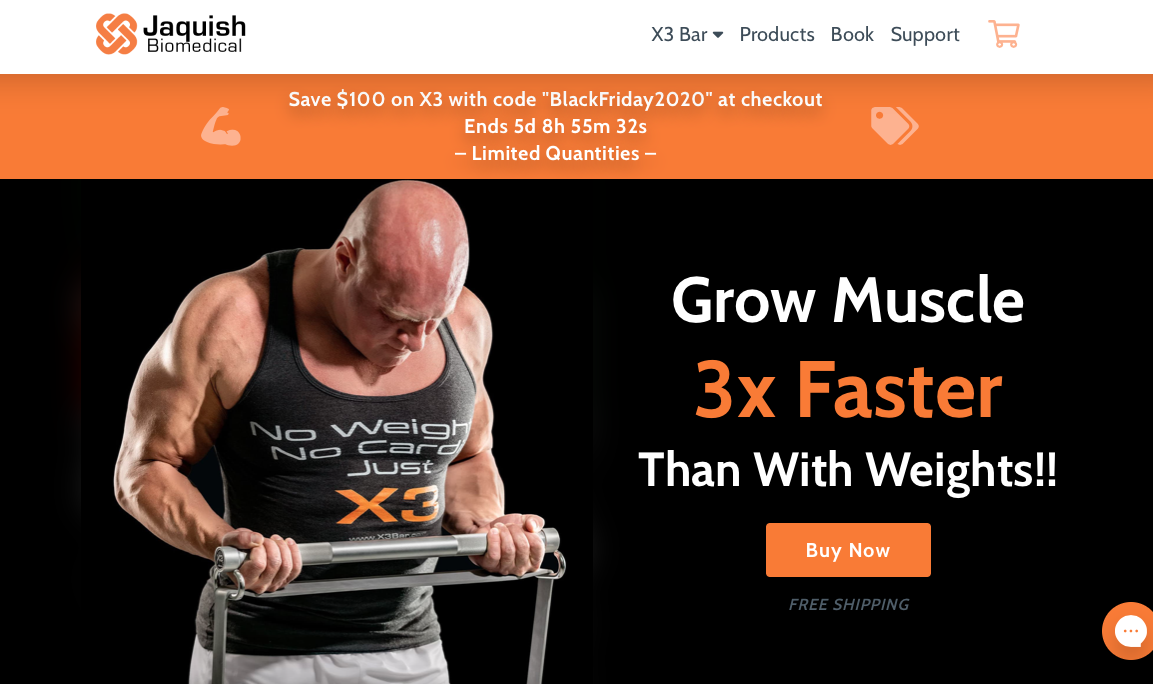Study: Resistance Bands Produce Strength Gains Similar To Weights
Training with elastic resistance bands produces strength gains similar to weights, according to a 2019 meta-analysis of the 8 high quality trial reports culled from a pool of 365 published articles that reported research involving resistance bands.
This report is a two-edged sword. One edge shredded claims that training with resistance bands is inferior to training with conventional weights. The other edge cuts down claims that training with resistance bands is superior to training with weights, including the extraordinary claim made by Jacquish Biomedical that training with the X3 bar grows muscle 3x faster than with weights.

Evidence-based claim? Nope. Still nice equipment.
Study Details

Lopes and colleagues analyzed data from 8 studies comparing outcomes of training with elastic resistance bands with those of training with conventional equipment (weights). These studies included 224 subjects aged between 15 and 88 years, all of whom had pre-established habits of performing strength training (they were experienced trainees, not newbies).
The subject pool included physically active people, athletes, people with coronary heart disease, and patients with moderate chronic obstructive pulmonary disease (COPD). The reports were published between 2003 and 2016.
All studies used weight machines for conventional resistance; one study used free weights. Four studies used the Thera-Band as for elastic band resistance, and the other four used elastic tubes (like the Bodylastics bands I use and recommend).
Duration of the training studies ranged from 4 to 12 weeks. Frequency of training ranged from 2 to 5 times weekly.
Methodological quality of the studies was moderate – 6.5 on the PEDro scale –, individual studies ranging from 5 to 8 (one scored 8, four scored 7, one scored 6 and two scored 5).
Resistance Bands Produce Strength Gains Similar to Weights
Meta-analysis of the outcomes for upper and lower limbs showed no superiority between training performed with elastic band resistance and training with weight machines and/or free weights on strength gain.
No superiority means neither tool produced superior outcomes. The authors represented the outcomes on forest plots:

As shown in the forest plots above, training with elastic resistance bands produces strength gains similar to weights. There is no statistically meaningful difference in outcomes. Bands were neither inferior nor superior to weights.
Lopes and colleagues performed a secondary analysis of the data to group health individuals and those with chronic diseases. Again they found no statistically significant differences in outcomes between training with elastic resistance bands and conventional weights or weight machines.
Training with elastic resistance bands produces strength gains similar to weights whether you are 18 or 88, male or female, or an athlete or patient with chronic disease.
Thus, the results of this meta-analysis indicate that both those who claim that elastic bands are inferior to weights and those who claim that elastic bands are superior to weights are unsupported by the evidence.
Simply put, training with elastic resistance bands produces strength gains similar to training with weights.
This really should not be surprising. Muscles do not know or care what is the source of the resistance against which they are made to exert force. Resistance is simply a tool to elicit a high degree of muscular tension for a sufficient period of time to stimulate increases in strength and muscle mass. So long as you train with adequate intensity, develop adequate levels of muscle tension, sustain that tension for a sufficient time period during each set, and repeat training sessions with adequate frequency, the source of resistance does not matter.
You can push or pull your own bodyweight, sand bags, logs, iron bars and plates, hydraulic resistance, flywheel resistance, any type of resistance that suits your fancy, or even apply self-resistance (use one muscle to resist another). That said, training with bodyweight calisthenics and resistance bands combined offers distinct advantages over other methods.
Muscles do not know or care what is the source of the resistance against which they are made to exert force. Resistance is simply a tool to elicit a high degree of muscular tension for a sufficient period of time to stimulate increases in strength and muscle mass. The source of resistance does not matter.
Limitations of This Analysis
One important limitation of this report is that all the data included in the meta-analysis came from studies comparing two types of resistance, weights and variable elastic bands, both of which provide uneven loading of muscles through the exercise range of motion, due to the interaction of leverage and the properties of the resistance source (weights or bands).
The actual load on the muscles at any point in the range of motion of a movement is a product of the resistance curve of the external resistance source (weights or bands) and the changes in the leverage as the limbs move through the range of motion. Both weights and elastic bands alone often fail to provide resistance closely matching the strength curve of many actions.
As I discussed in a recent post, a study comparing muscle activation of biceps in arm flexion and quadriceps in knee extension against either weights, elastic band resistance, or combined weights and elastic band resistance found that both weights and elastic bands failed to provide adequate resistance at all points in the range of motion.
For example, during arm flexion (bicep curls) elastic bands alone produced the peak bicep activation at 50º of elbow flexion, and weights alone produced peak bicep tension at 90º of elbow flexion.
In comparison, combining weights and resistance bands improved the resistance curve so that it more closely matched the strength curve of each exercise. This means that simultaneously combining the two forms of resistance produces more even loading and therefore longer time under high tension during every repetition and set.
With a better resistance curve, one set can equal several sets in actual time under heavy load and high muscular tension. For example, when performing bodyweight split squats, the muscles work hard in the bottom half of the squat, but the top third of the ROM is quite easy due to leverage. This means that the muscles are only working hard for about one-third to one-half of the ROM and time spent doing full range repetitions the conventional fashion. Now add some bands and the upper ROM becomes far more difficult due to the variable resistance of the bands. Now your time under heavy load per repetition has doubled or tripled. This makes one set similar to three sets without the bands.
I recommend combining closed-chain bodyweight squatting and upper body pushing exercises with elastic resistance bands. For example, doing push ups with resistance bands or ATG split squats with the X3 bar:
By adding resistance bands to bodyweight exercises you get isoinertial resistance from weight – your bodyweight – and variable resistance from the resistance bands. By using combined resistance for pushing exercises, you get a resistance curve that more closely matches the strength curve of the movement produced by your body levers.
This might elicit greater strength and hypertrophy gains per set performed than using either mode of resistance alone. This remains a hypothesis awaiting confirmation or rejection by well-designed studies.
Nevertheless you have nothing to lose by using combined resistance in your own training. Since training with elastic resistance bands produces strength gains similar to weights, by using combined resistance – bodyweight plus bands – you will get results at least as good as you would get by using weights alone.
Free Yourself From Weights and Gyms
As Lopes and colleagues conclude, "These findings allow coaches, physiotherapist, and even patients to opt to use devices with low costs, ease of handling, and which can be used in different places, such as elastic devices, for maintenance and gain in muscular strength."
Basically, since training with resistance bands produces gains similar to training with weights, you don't need weights to achieve your strength and hypertrophy goals. You can use bodyweight exercises – primarily pull ups, push ups, and squats – supplemented with elastic resistance bands to get combined resistance.
|
Bodylastics bands are the best elastic tube resistance bands on the market. You can get 262 pounds of band resistance for just about $90. Combined with my DIY band platform, that's more than enough for loading overhead press, push ups and single-leg split or pistol squats to your genetic potential. All that resistance fits into a small carry bag that can go anywhere you want to train. | |
|
Combine with a set of rings for doing brachiation/hanging and chin ups, and you might have a complete home gym. Rings will fit in a small bag and you can hang them from many overhead supports such as rafters and large swing sets in play grounds. |
|
However, you might need a CAP pull up bar or portable Go Beast bar to hang your rings at home or on the go. |
Extraordinary claims require extraordinary evidence. Although we presently have no such evidence that training with elastic bands will 'grow muscle 3x faster' as claimed by Jaquish Biomedicals in their marketing for the X3 bar, and the X3 is more expensive than Bodylastics bands, I like, use and recommend it for overhead presses, ATG split squats, and front squats. Although I don't think it is essential equipment for a home gym, its a nice piece of equipment to have if you want the feel of a barbell for the stated exercises.
Recent Articles
-
High Protein Chocolate Tofu Pudding
Jul 01, 24 12:41 PM
A delicious high protein chocolate tofu pudding. -
Vegan Macrobiotic Diet For Psoriasis
Sep 05, 23 06:36 PM
Vegan macrobiotic diet for psoriasis. My progress healing psoriasis with a vegan macrobiotic diet. -
How Every Disease Develops
Aug 04, 23 06:22 PM
How every disease develops over time, according to macrobiotic medicine. -
Why Do People Quit Being Vegan?
Jun 28, 23 08:04 PM
Why do people quit being vegan? How peer pressure and ego conspire against vegans. -
Powered By Plants
Mar 16, 23 08:01 PM
Powered By Plants is a book in which I have presented a lot of scientific evidence that humans are designed by Nature for a whole foods plant-based diet. -
Carnism Versus Libertarianism
Dec 30, 22 01:55 PM
Carnism Versus Libertarianism is an e-book demonstrating that carnism is in principle incompatible with libertarianism, voluntaryism, and anarchism. -
The Most Dangerous Superstition Book Review
Nov 15, 22 08:46 PM
Review of the book The Most Dangerous Superstition by Larken Rose. -
Plant-Based Diet Is Best For Health Protection: Meta-Review
Oct 17, 22 11:22 AM
A plant-based diet is best for health promotion according to a meta-review of more than 300 reviews published 1950-2013.











